People who know me have probably noticed that wherever I go, I wear my headset most of the time. The reason is that I am always lost in my thinking, I am constantly trying to solve a problem in which case I will be listening to music. Or if I need inspiration I would be listening to a podcast. One of them – an extremely popular one – is Tim Ferriss’s show. In the intro of each episode you can hear random quotes from many successful entrepreneurs, one of them by Tim himself:
What if I do the opposite?
Retirement
Back in December 2016, I thought of making Tokyo Marathon 2017 my last marathon as I was no longer enjoying the training. I’m in a place where lowering my marathon pace by even one second demands a tremendous amount of grind. I have often tried to make sense and question the sanity of this runner’s obsession: chasing a never-ending goal to beat his/her next personal best. What was the reason? perseverance, stubbornness, stupidity, obsession, pride? I think a bit of everything. The bottom line is that I could not find any enjoyment in running hard threshold pace run and fast long runs weeks over weeks, focusing on my splits every single kilometers, weighing myself twice a day, taking pictures of all the food I eat, counting my macro nutrients, my sodium, potassium and magnesium intake tracking my sleep and nervous system etc. It sounds a like a lot but once all these things become a routine, it’s not that hard anymore. The hardest part is to dive in cold turkey in the cold pool, once your body has accustomed to the temperature, it’s no longer as hard as it seems.
On November 5th, I ran the Namban Half in 1:2133. I ran pretty hard that day. To beat my PB I had to run double the distance at a faster pace. I’ve got work to do. That day marked DAY1 of my training to Senshu Marathon on February 18th 2018 – 15 weeks to go. To make sure 2018 was my last marathon season, I signed up for Koga Hanamomo marathon held 3 weeks later on March 11th as a plan B (in case of terrible weather or execution screw-up). I had never raced two A-race marathons in such a short period of time but I wanted to minimize the impact of uncontrollable parameters, and I wanted to maximize my chances to retire after that – that is beat my PB of 2:42:54. I started the training with Senshu as the target A-race, and hoping to DNS for Koga.
My best failures
I remember when I was at school, after each math test, the professor would spend an entire 2 hours to review all the questions. I never bothered to listen, I was convinced it was a waste of time. Especially if I had received a bad grade. The frustration and the anger consumed me to the point where looking back was felt like a shame and moving forward was the only thing acceptable. And so while the professor was going over the questions of the test, I was already living in the future and trying to learn the next chapter during the class. I was an idiot. Today I do the total opposite. I cherish my failures they make me grow and help me expand my knowledge.
Today I feel excited when I’m proved wrong, because it means I can do better
Last year’s Tokyo Marathon and Nobeyama 100k taught me a few things:
- I should avoid carb loading.
- The earliest timing to re-feed must be on Friday.
- Water retention is huge
- Racing weight can completely destroy your race (trashed quads from 25k, anyone?)
- I should not build strength training and intensity running at the same time.
- I should keep the intensity high until race week
Being a coach gives me the chance to test out training methods on my athletes. I have always felt that threshold training (or slightly above) is the most efficient way to train for a marathon. Most people I know do lots of track intervals and lots of either easy miles or junk miles (not easy enough to be really easy, not fast enough to provide a training stimulus). Lots of runners don’t do threshold runs because it sucks. It is extremely difficult and painful.
I needed a Guinea pig
A mentally strong athlete, fast, that is willing to put on the work and also wise enough to back off when necessary. Among the group, one name came up, for the sake of anonymity, let’s call him Renaud.
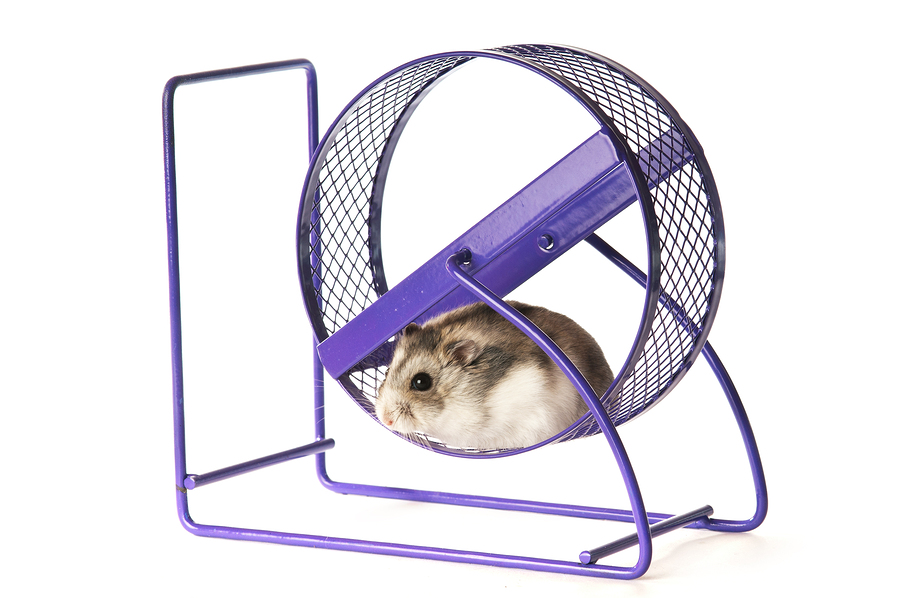
I put him through a lot of threshold run. Once or twice a week. I knew he hated it. But he never complained. So I kept pushing him. I’m pretty sure he must have cursed me a lot. In the end he ran 2:57 at Tsukuba in November, improving his best time by about 12 minutes. He has not fired me yet so I suppose he doesn’t hate me too much. That was the starting point of an experiment I was willing to test on myself.
Before the start of these 15 weeks block, I had already built back:
- Raw strength: by doing barbell back-squat and dead-lifts (120% body weight, more about this topic here and here)
- Raw speed: 400s reps in 72~74s
- Raw power: plyometrics twice a week (bouncing drills, hill sprints, flat sprints, strides, jumping lunges etc)
- Base: running 140km per week felt “easy” – meaning I could recover very quick and was not feeling too tired at the end of the week
So for these 15 weeks, my goal was to lower my threshold pace. To make sure I could track my progress (or lack of) I chose to run on the treadmill. Don’t get me wrong. It sucks, I hate the treadmill. BUT a threshold session is painful no matter where you do it. Even on a street full of Sakuras, birds, trees, naked women etc. it is very painful. So I opted for the treadmill because I can eliminate lots of uncontrollable parameters: the weather – wind speed, rain, temperature , incline. That way I can better interpret my heart rate and my RPE (rate of perceived exhaustion). Also the treadmill is more forgiving on the joints, I feel less beaten up after a hard session on the treadmill vs the track. The parameter that was left unknown was the running form. The muscle groups engaged in both case differ slightly. The treadmill shifts the load on the hip flexors, while running outdoor will stress your hamstrings a bit more at the same speed. Since the hamstrings are much bigger than the former, it means that running on the treadmill is actually easier than outdoor. Yes I could change the incline to compensate but then more work would be put on the calves… That was the parameter left to luck.
The runner’s time dilation
With 15 weeks, I estimated I could do between 14 and 17 threshold runs. With a bit of taper and no treadmill access during the year end holidays that meant some weeks with two sessions. For each session I would lower the pace by 1s/km vs the previous run. In the end, I managed to run 16 sessions. Going from 3:40 to 3:26 min/km. I recall on some occasions, I was going so dang hard that my head was going to explode, my HR was through the roof – above 195 bpm over 5min. At that heart rate, each seconds feels like an eternity, for lack of better word I like to call that the runner’s time dilation.
Finally the last piece of the puzzle is the fast long runs. When you are an experienced runner (meaning you have already trained and run many marathons in your running career – regardless of your speed), a LSD is no longer useful. Thanks to the ultra-distance training I’ve done for the past few years, I am able to recover very quick from a 42km run. As a result, many of the fast long runs covered 42km, with the portion at marathon pace increasing week after week (marathon pace was RPE based, about ~3:50 min/km). So in a nutshell, what I did “against” conventional training program were:
- Doing only threshold as a form of intensity (ditching the track) solely on the treadmill
- Doing lots of marathon pace runs
- Going low-ish carb, about 100~150g per day
- Running regularly 42km fast long runs
- Eating twice a day (Breakfast and dinner, skipping lunch has become a habit)
- weekly 36hours fast from Sunday evening to Tuesday morning.
- The final 8 weeks had a ratio of intensity/mileage between 40% and 50% (conventional training would have you do 15~20%)
I had no idea if all these was going to work, but I was willing to give it a shot a go 100% all-in. Even if I don’t make it, I am sure I will learn from it, that was the most important.
I know, it sounds like a lot of suffering for just (possibly ) a few seconds of improvement, and before starting this whole thing I really thought I was going to hate it. But in reality, stepping back, there are only 1~3 hours per week that are horrible. These 3 hours makes me appreciate the other 165 hours of the week a lot. I sleep very well, the food taste better and mostly I love playing with my own data from the training and experiment I get. That satisfies the Otaku in me which provides me with a great feeling of satisfaction. I am very excited whenever I log my runs and do my analysis. Same excitement when I receive a feedback from an athlete that has successfully completed a hard workout. I hear you: “so you’re willing to pay a weekly 3 hours in hell just to play your real life video game”. Call me nuts but I have to say “Yes I do”.
Ten days out from the race, I was starting to look at the wind forecast. As the race was held along the coast, it could be a deal breaker. I had the plan the DNS if the wind was going to blow higher than 15km/h and keep it for Koga three weeks later. I was checking an app called windfinder 4 times a day at least (the pre-race paranoia). Two days out, the forecast was saying about 12km/h, side-wind a sometimes headwind.
Godzilla
Senshu is a city located in Osaka prefecture, it is actually where the international airport located. We booked a hotel one station from the start which took place in a small park in the city of Sakai. The course have you run along the sea and you finish near the airport. As I was in the A block, the start was pretty smooth. About 4000 runners at the start and lots of portable toilets. Despite the size of the city I was surprised to see the number of spectators. They were present for more than 80% of the time and the cheering was surprisingly very animated. Plenty of aid stations (every 5~7km) and super flat for …hmm … the most part (more on this below)
The first 5km are always the most stressful for me. They are the most important part of the race. It is when you can fuck up your entire race and throw out months of training out of the window in 20 minutes. Your subconscious always want to go faster, people around you go faster, your rested legs want you to go faster, your balls want to fly away before your legs. But the price to be paid during the last 10km will be very expensive. As John L. Parker Jr. wrote in “Once a Runner”
“A runner is a miser, spending the pennies of his energy with great stinginess, constantly wanting to know how much he has spent and how much longer he will be expected to pay. He wants to be broke at precisely the moment he no longer needs his coin”
I love this metaphor. I tell my athletes, myself included, that we MUST save the coins and not spend it all before the finish line. If we ever spend it all before, the interest rate of borrowing coins (energy) will be over 300%. If we run faster than our potential that day early in the race we will pay at least 3 times the price. How many times have I seen people who still believe in the concept of borrowing time. Like a runner aiming for a sub3 (4:15), running the first 10k at sub 4:00 pace (hoping to “bank in” some time) and running the last 7km at 5:00 pace… Don’t do that. Don’t borrow money. Spend wisely. Because I was aiming for a PB I had to run very close to this fine line while staying below. Extremely difficult task. I always keep in mind that a marathon is all about the last 10km. I must do everything I can to be ready to RACE at 32km, and not just “hanging in there”, no death zombie march. I want to be in control for the last 10km, to be able to run hard and avoid the time dilation. At the 31km mark, Celine was there and screamed at me “GO BABE GOOO”, that was for me the trigger to give it all. My breathing then switched from a 3-2 pattern to a 2-2 pattern, I was going very hard.
If you scroll down the race’s website, you can read this:
A challenge awaits you at 34km point where two big bridges called the Monster Bridges. Watch sea gulls glide and airplanes land and takeoff at KIX from the course.
The bridges in question are illustrated this way:
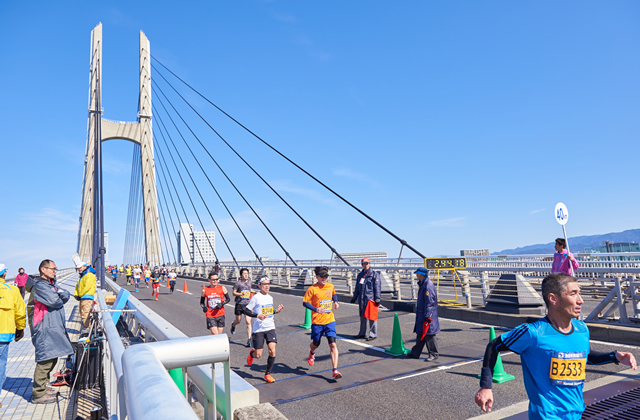
But in my mind, it looked more this

The bonus is that you have to run through the two monster bridges twice (back and forth). In the end, despite running through Godzilla four times, the race execution went well, I did not burn out and almost run a negative split (12s from en even split) if only the giant reptile had decided to remain under the ocean. I still managed to run the last two km 5s/km faster than the first 40km.

But in the end I did NOT beat my PB as I finished in 2:43:34, that is 42s slower than my PB set two years ago. But I was extremely happy with my execution, I did my best and on that day I don’t think I could have done anything better. I then slowly walked in search of the wifey. She asked me “so I guess you’re not retiring yet…?” “No I’m not, I’ve got a second shot in 3 weeks… but I need an ice cream first”
Beeturia
From wikipedia:
“Beeturia is passing of red or pink urine after eating beetroots or foods colored with beetroot extract or beetroot pigments”
With three weeks left, in terms of training, the only thing I can do is active recovery and fitness maintenance. After 2 rest days and 1 day of easy elliptical , most of my soreness were gone. I capped my single long run at 90min and followed a classic reverse-taper protocol: pyramid shaped mileage over three weeks with 3 tempos, 1 long run, some strides, sprints and one short VO2 session. Higher protein intake, fish oil and magnesium.
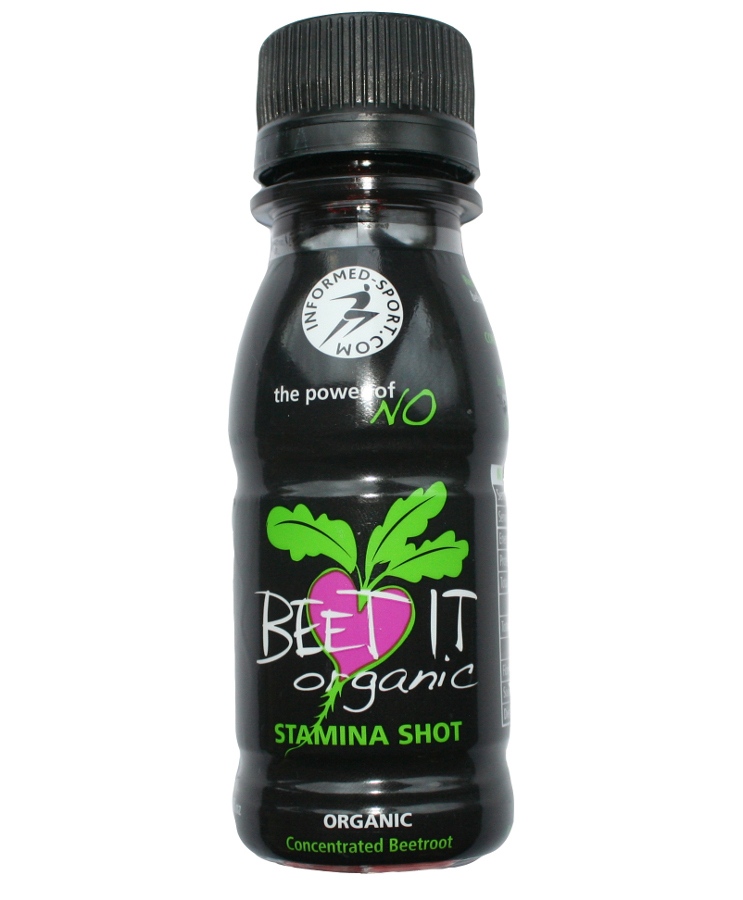
The week end after Senshu I attended the annual Tokyo Marathon post race party with Namban. I had a chat with one of my friend, Francesco, who asked me if I tried beet root juice. I told him I did 3 years ago but did not notice any significant ergogenic effect. Besides my funky pee color, nothing much happened. He asked me which protocol I followed. I told him I did the acute one (one single shot). He suggested I should try the loading protocol. At this point I had nothing much to loose as soon as I got back home I dived into the research and got surprised that since then, tons of experiments had been done and a big meta-analysis had been compiled. In a nutshell the nitric oxide found in beets when consumed in large amounts creates a vasodilation that can potentially improve the aerobic capacity.
Body-weight yo-yo
It took me years to understand how my body-weight reacts to food, stress and sleep. As you can observe, the daily fluctuation is rather big. The big sudden drop we can see if from the removal of a hidden source of sodium ( the “salada chicken” from the konbini, loaded with ridiculous amount of sodium). The two red dots are the two race days.
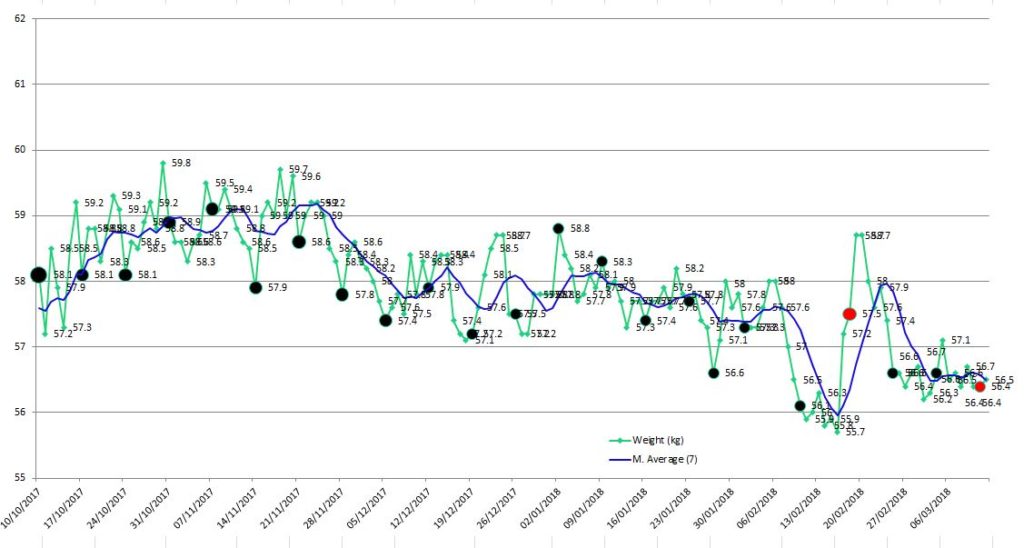
For Senshu, I had a “light” carb load where I would eat a generous amount of rice and some bread on Friday and Saturday for lunch. This resulted in an unwanted (but expected) weight gain of 1.7kg (from 55.8kg to 57.5kg).
During the three weeks in between, I had a relatively low carb intake, about 100g daily. But in order to avoid the weight spike I had for Senshu, I did not carb load at all. While all the advice you will find on the web, books etc tell you to eat well the day before a marathon. For the past 10 years, for every single race, I would eat well the day or two before the race. This time around I told myself: “what if I just do the opposite…? ” So on Saturday I almost fasted. I had a light breakfast after a 8km run and that was it, no lunch and no diner. On race morning I was 56.4kg (1kg lighter vs 3 weeks before). I had a double shot of beetroot juice concentrate, one banana, and a triple shot espresso (about 250kcal total). I had not much to loose as on the morning of the race, I could still feel some residual niggles/fatigue from the previous race. Also I was a bit concerned about the little fuel and carbs I’ve had during the 3 weeks between the 2 events, let alone the almost-full fast the day before… My only hope was that the lighter body-weight and beetroot compensate for it. Yes, I was tossing a coin.
The first half was my fastest half in a marathon (1:20:26) and it never felt so “easy”. Now I can’t tell whether it was the body-weight, the beetroot or the temporary adaptation from the previous race. Maybe a mix of everything. Unfortunately, my concerns about the residual fatigue and/or the potential lack of carbs hit me around 25km were I could feel some soreness on parts of my legs that I had right after Senshu. I ended up running the second half 1 minute 39 seconds slower than the first half… But eventually, I ran overall 1 minute and 3 seconds faster and beat my PB by 23 seconds with a net time of 2:42:31

It is only 23s, but I think I gave the best of myself during the 18 weeks leading to it. I have learned more about my own limits and perhaps a bit more about human physiology in general. The way I felt during the first half of the race gives me high hope that I can still improve so maybe the retirement plan will wait … 🙂
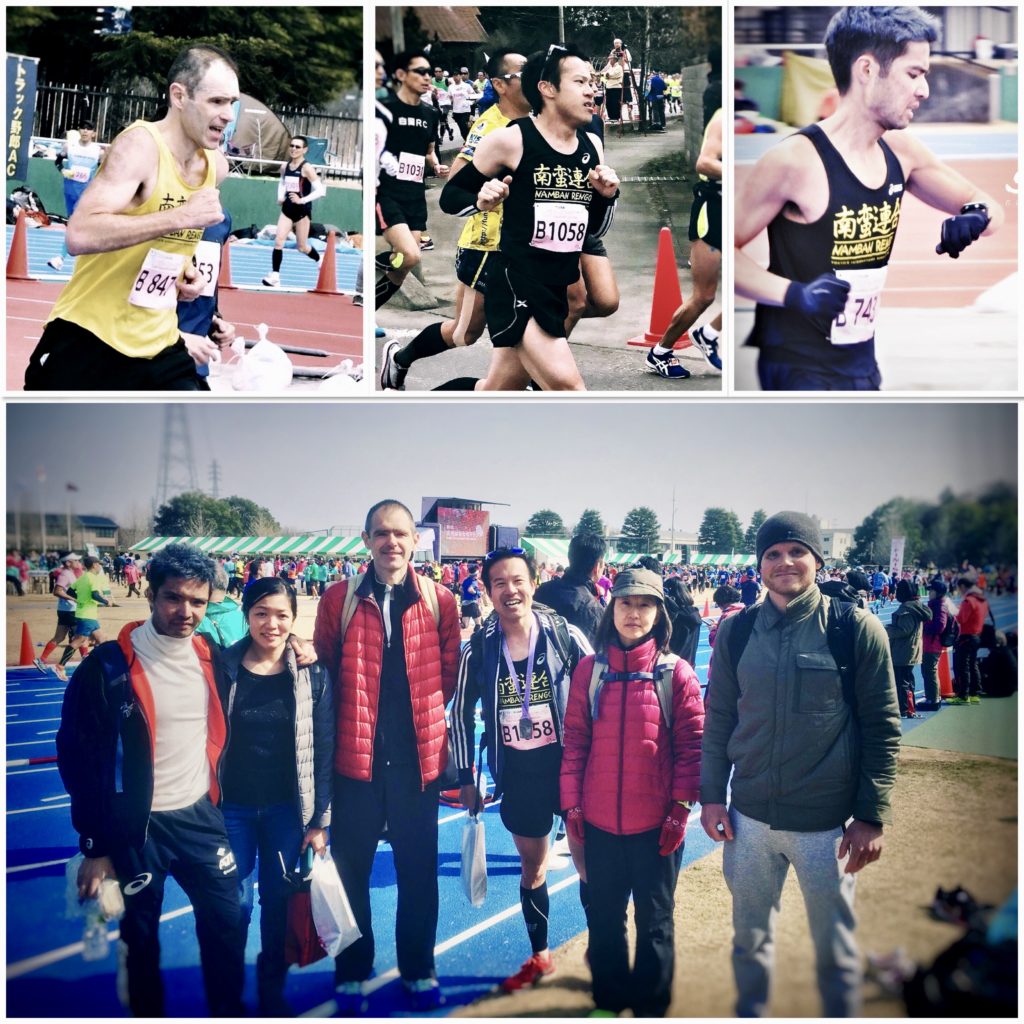

Very Interesting Blog Harrison
Now we have some real material data to get you to your true PB which I still believe is minutes quicker. A few points in no particular order;
1) Put down the weights. They’re essential for distances up to 1500m they are a drag for a marathon, no marathon champ has any upper body physique. You are just adding ballast.
2) Carbo’ loading is not feasting on carbs it’s moving from 70% carbs to 98% carbs, you do not eat yourself silly you just eat only pasta (my favourite).
3) Don’t skip meals, ideally you should have six v small meals to keep you topped up. OK in the real world let’s try three modest meals including breakfast.
4) Don’t get time obsessed with your threshold runs etc. Two months before the race you will probably still be a couple of kilos over your race weight and that will mean a 3:30 m/km pace run will feel hard. Do time your runs but run more by feel.
5) Tapering involves a dramatic reduction in weekly mileage only in the last 12 days. (The tapering research comes from swimmers who suffer less penalty from weight gain than runners). For example if I did 160km three weeks before the race I would do only 80 in race week and 42 of that would be the race. But then if that means I only do 8km say on the Wednesday before the Sunday it would be bloody fast, way above my race pace, but it couldn’t tire me.
6) Training is either recovery (chatting etc, being lapped by people who naturally have haircuts like Jurgen) OR balls out whether it is threshold or intervals or a race. Part of training is learning how to push yourself and also how to restrain yourself.
7) The minimum rep distance for marathon training is 1.5km or six minutes effort if you do it on time rather than distance. Only once a week, four reps with say 400m or 2 mins recovery. Shorter reps are for shorter races. (I’ve checked this out with three different sub 2:30 training groups and they all do this).
8) Always put a recovery day between the effort so a simple week looks like Hard (reps) Easy (recovery) Hard (Long run) Easy (recovery) Hard (Threshold) Easy (recovery) Rest Day (recover your marriage) Obviously mix it up but keep the gaps between the hard days. (Recovering your marriage might be a hard day but it doesn’t count in your training, I think you blessed with an extraordinarily tolerant partner).
9) Don’t mix ultra training with marathons, just as you wouldn’t do marathon training to get a half-marathon PB.
10) Treadmills are fine, just put 1-2% incline on for the lack of wind resistance. Very good for threshold runs as if you slack off you fall off:-)
11) The long run must start slow and finish fast. Get out to a duration where it is as long as you expect your race to be , so say 2:45.
12) Marathon race execution is a separate topic but I’ll throw one idea in now. Go to the track and use the 400m to learn exactly what it feels like to run at your initial target pace first checking with a watch and then just learning it until you can feel it. When you line up just visualise going off at the pace you programmed your legs to do at the track.
Hi Greg
Thank you so much for taking the time to read and to write such a detailed comment, I really appreciate !
Let me go through some of your points:
1/ Weights are built before the 16weeks, during the 16weeks, leading to the race, I do it once a week just to maintain. After all Salazar gives lots of credit to M. Farah’s ability to lift weights for his marathon preparation (link I provided in post) but I hear you. The shorter the distance the more weight training will have a positive impact. The other side of the spectrum being sprinters
2/ I have tried everything from 3 days full on carb load to medium, to 3 meals, 6 meals, 1 day, 2 days, 3 days, 4 days, counting every grams of carbs from 100g to 500g per day etc. I don’t think there is a magic formula but with my own N=1 experiment I have come close to what works for me, that is just Saturday, one good meal.
3/ same, I have experimented in 4 weeks blocks, 1 meal, 2 meals up to 8 meals. I feel good with 2 meals. Again I am not saying it is THE way to eat, but on my body seem to like it that way
4/ you’re right on this one !
5/ yes ! that’s what I do, 2 weeks out, my training become super polarized. Very easy or very hard. I agree 100%
6/ same here, my easy runs are very easy, my quality runs are no joke.
7/ yes think for my next season I will keep on foot on the 400s repeat and not let it down completely.
8/ that’s what I do. I don’t do back to back two intense runs, two intense sessions are always separated with easy runs
9/ It might not sound like it but I do not mix ultra and marathon training. I cover 42km for my long runs but I cap all my long runs at 3hours. I’m just saying that I am so used to run very long that running 42km does not break me down as much as it used to
10/ the treadmill is always set at 1% incline, but still, by nature, the hip flexors are more engaged than the hamstrings.
11/ All my long runs have a fast portion. I built it up from 5k to 26km fast (in a 42km run). All my long runs finish fast. every single one of them. All capped at 3hours max.
12/ I’m still working on it and I believe it is 50% art, 50% science 🙂 but I will try your advice on the 400m !
Thanks very much Greg, again I really appreciate you took the time to give me these advice
Hope to see you back in Tokyo for a drink 🙂
Great! Thank you! Insightful into your training.
Thank you David
Congrats on your PB, Harrisson. That’s really impressive considering the circumstances. I enjoyed reading about all the details that went into your training and preparation. Personally, I had a bad race at Koga Hanamomo because I went out too fast and messed around with my nutrition pre-race. It’s always good to be experimenting, but probably not making any big changes before a full marathon!
Thanks a lot David
Experimenting is the BEST way to learn. It is worth more than reading tons of papers in my opinion. You might have had a bad race but the experience gained from it is priceless. For next season I’m sure you’ll nail it !!
I know no one who can control dilation of their eyes. It is always a drug(s). Women in the old days used to take bella donna for the dilated eye effect..maybe women of the night know stuff we don”t. Dilated eyes have always been associated with a sexual attraction. Maybe it was Anderson Cooper?!?